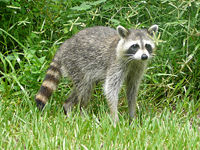Raccoon
| Raccoon | ||||||||||||
|---|---|---|---|---|---|---|---|---|---|---|---|---|
 | ||||||||||||
| Scientific classification | ||||||||||||
| ||||||||||||
| Procyon lotor Linnaeus, 1758 | ||||||||||||
|
Procyon cancrivorus |
A raccoon (or racoon) is any one of three species of nocturnal mammals which constitute the genus Procyon of the Procyonidae family. The most widespread species, the Common Raccoon (P. lotor), is often known simply as the raccoon, as the two other raccoon species in the genus are native only to the tropics and are considerably lesser-known.
General attributes
Raccoons are unusual, for their thumbs (though not opposable) enable them to open many closed containers (such as garbage cans and doors). They are omnivores with a reputation for being clever and mischievous; their intelligence and dexterity equip them to survive in a wide range of environments and are one of the few medium-to-large-sized animals that have enlarged its range since human encroachment began (another is the coyote). Raccoon hindfeet are plantigrade similar to a human's. Raccoons are often considered a nuisance, and are common in campgrounds of North America, especially in the Midwest. Many people are surprised when a creature that they usually think of as cute or cuddly raids their campsite at night and makes odd growls and fights viciously over scraps of food left out by campers.
Although there is some variation depending on the species in question, raccoons range from 20-40 inches in length (including the tail) and weigh between 10 and 35 lbs. The raccoon's tail ranges from 8 to 16 inches in length. Male raccoons are generally larger than females. A baby raccoon is called a kit[1].
Species
There are three species of raccoon. The most widespread is the Common Raccoon, also known as the Northern Raccoon, which has a natural range of Southern Canada to Southern Mexico and has been introduced to Continental Europe. Raccoons can live in the city or in the wild, and while they are not domesticated they are on rare occasion kept as pets.
The two rarer species are the Tres Marias Raccoon (P. insularis), native to the Tres Marías islands off the Pacific Coast of Mexico, and the Crab-eating Raccoon (P. cancrivorus) of tropical Central and South America.
Some raccoons once considered separate species are now thought to be the same as or subspecies of the common raccoon, including the Barbados Raccoon (P. gloveralleni), Nassau Raccoon (P. maynardi), Guadeloupe Raccoon (P. minor), and Cozumel Island Raccoon (P. pygmaeus) (Helgen and Wilson 2005).
Nomenclature
The word "raccoon" is derived from the Algonquian word aroughcoune, "he who scratches with his hands." Spanish-speaking colonists similarly adopted their term, mapache, from the Nahuatl word for the animal, meaning roughly "that which has hands."
The genus name, Procyon, comes from the Greek for "pre-dog"; this term is also used for the star Procyon of the constellation Canis Minor.
Raccoons are today understood to have a relatively loose evolutionary relationship with bears which was nonetheless seen as significant by the early taxonomists; Carolus Linnaeus initially placed the Raccoon in the genus Ursus. In many languages, the raccoon is named for its characteristic dousing behavior in conjunction with that language's term for "bear": Waschbär in German, mosómedve in Hungarian, vaskebjørn in Danish and Norwegian, tvättbjörn in Swedish, wasbeer in Dutch, pesukarhu in Finnish, araiguma (洗熊) in Japanese, orsetto lavatore in Italian, huànxióng (浣熊) in Chinese and миеща мечка in Bulgarian all mean "washing bear."
In some cases, the "washing" descriptor is applied only to the Common Raccoon species: for example, in French the common raccoon is called raton laveur or "washing rat," while its Linnaean binomial is Procyon lotor or, roughly, "washing pre-dog." In contrast, the Crab-eating Raccoon is "little crab-catching rat" (raton crabier) and "crab-eating pre-dog" (Procyon cancrivorous) in French and Latin, respectively.
Literature
- Helgen, K.M. and Wilson, D.E. (2003). Taxonomic status and conservation relevance of the raccoons (Procyon spp.) of the West Indies. Journal of Zoology 259: 69-76.
- Helgen, K.M. & Wilson, D.E. 2005. A systematic and zoogeographic overview of the raccoons of Mexico and Central America. Pp. 219-234 in Sanchez-Cordero, V. & Medellin, R.A. (eds.). Contribuciones Mastozoologicas: en Homenaje a Bernardo Villa. Mexico City: Instituto de Biologia e Instituto de Ecologia, UNAM.
ReferencesISBN links support NWE through referral fees
See also
- Coonskin cap
- Raccoon Dog - an unrelated animal sometimes confused with raccoons
- List of fictional raccoons
- Red Panda
- Maine coon
External links
- Raccoons on Bear Tracker
- Raccoons on an elementary school website
- World Wide Raccoon Web Gallery
- Raccoon pictures
Credits
New World Encyclopedia writers and editors rewrote and completed the Wikipedia article in accordance with New World Encyclopedia standards. This article abides by terms of the Creative Commons CC-by-sa 3.0 License (CC-by-sa), which may be used and disseminated with proper attribution. Credit is due under the terms of this license that can reference both the New World Encyclopedia contributors and the selfless volunteer contributors of the Wikimedia Foundation. To cite this article click here for a list of acceptable citing formats.The history of earlier contributions by wikipedians is accessible to researchers here:
The history of this article since it was imported to New World Encyclopedia:
Note: Some restrictions may apply to use of individual images which are separately licensed.



